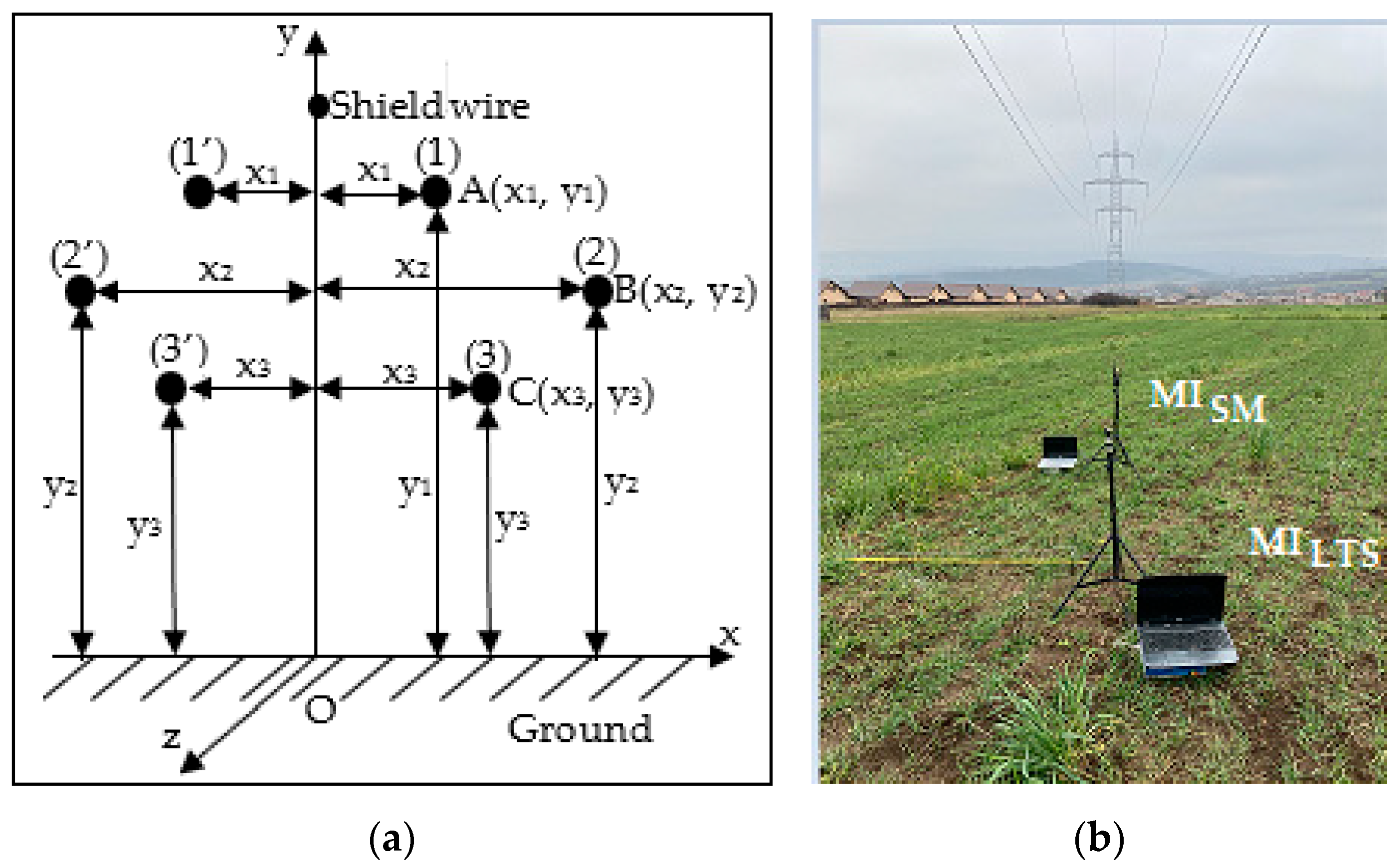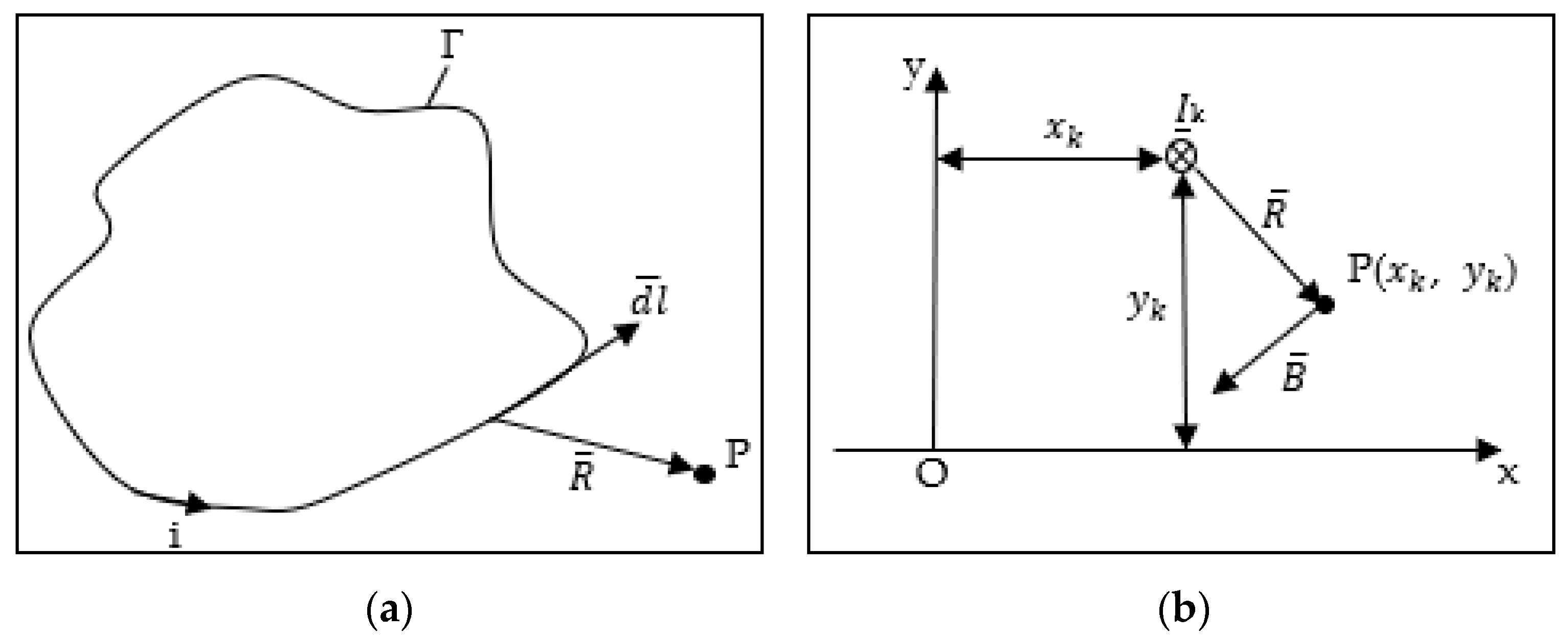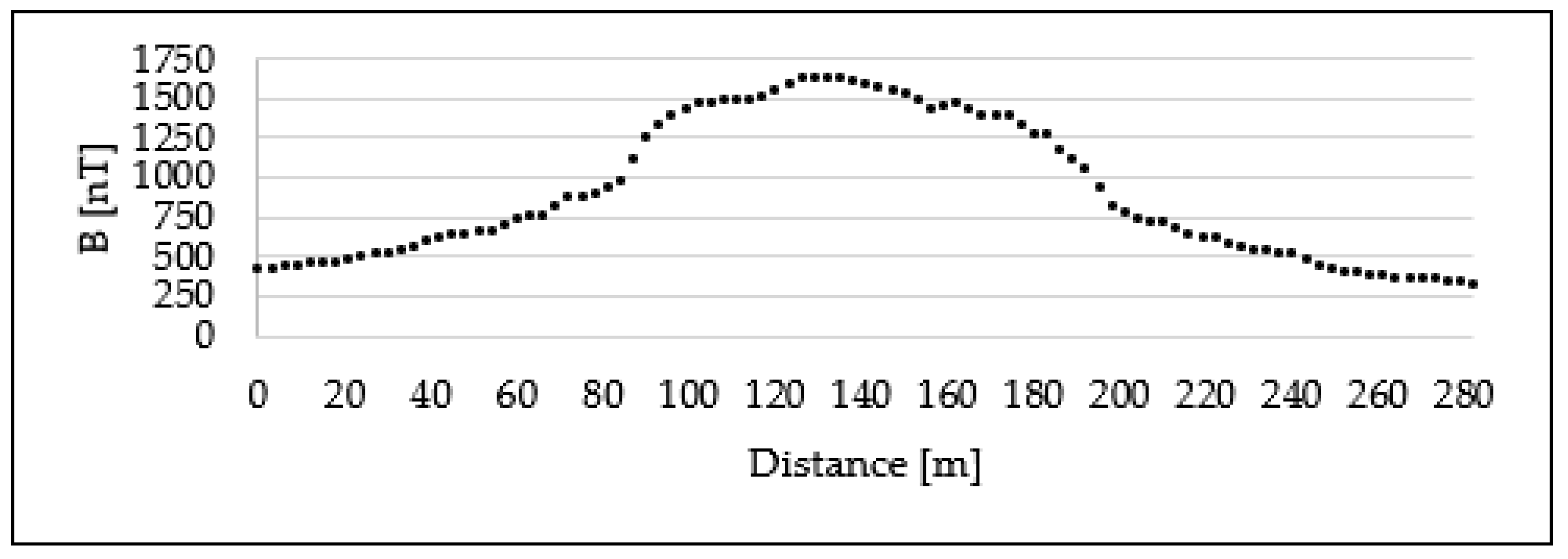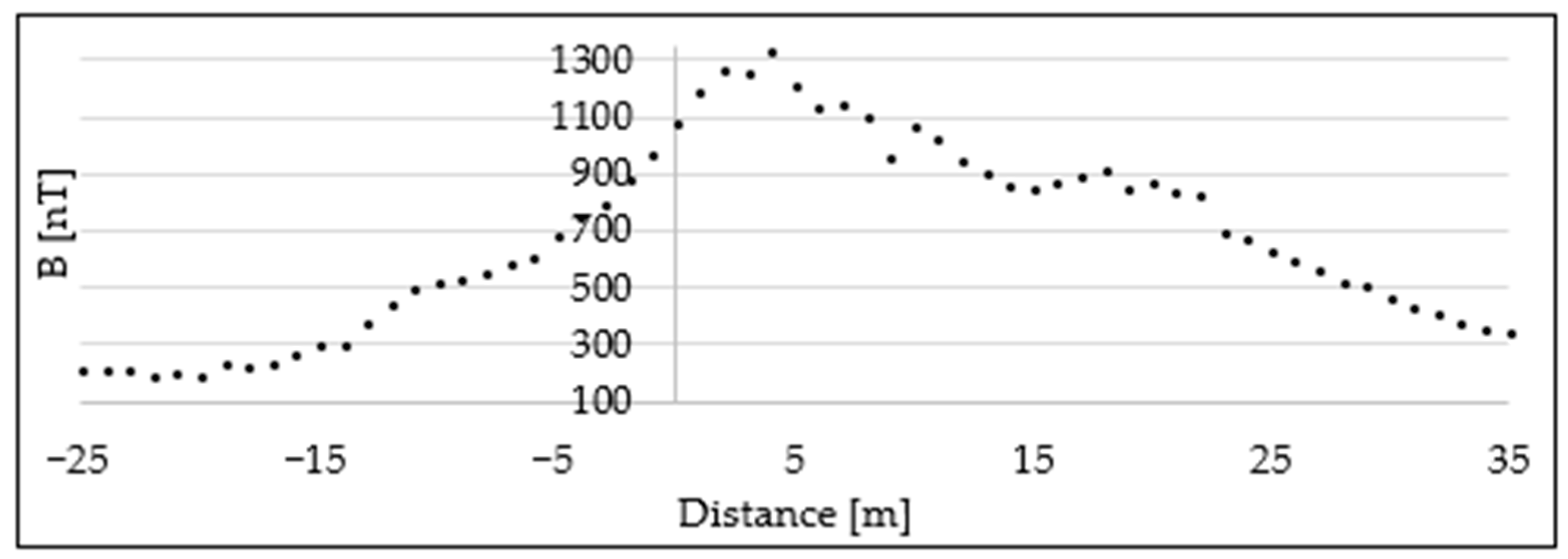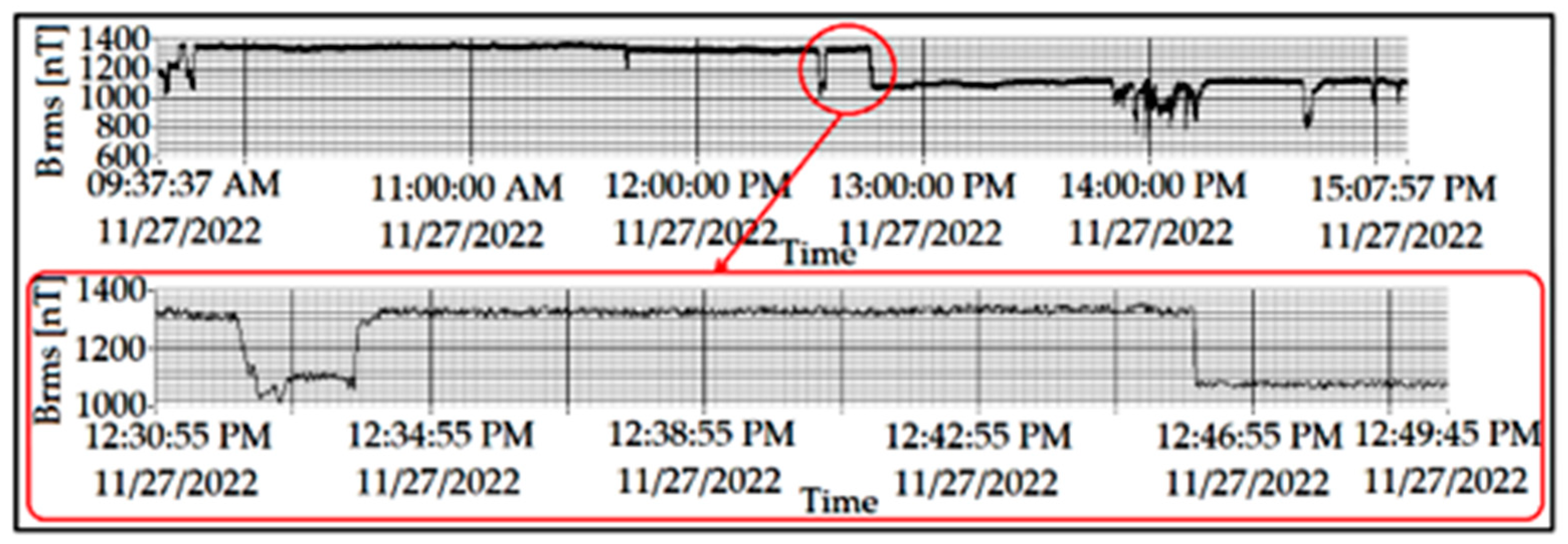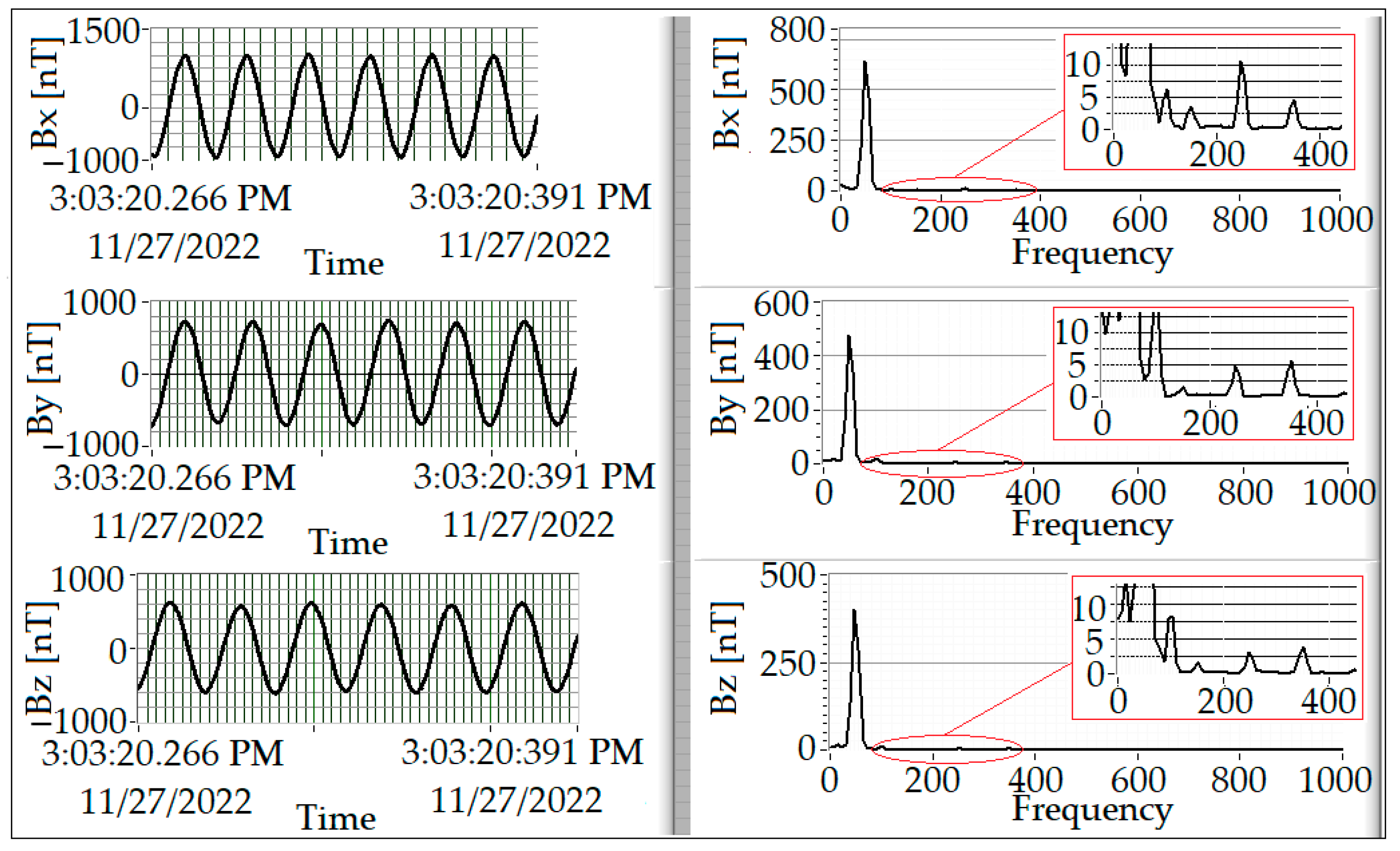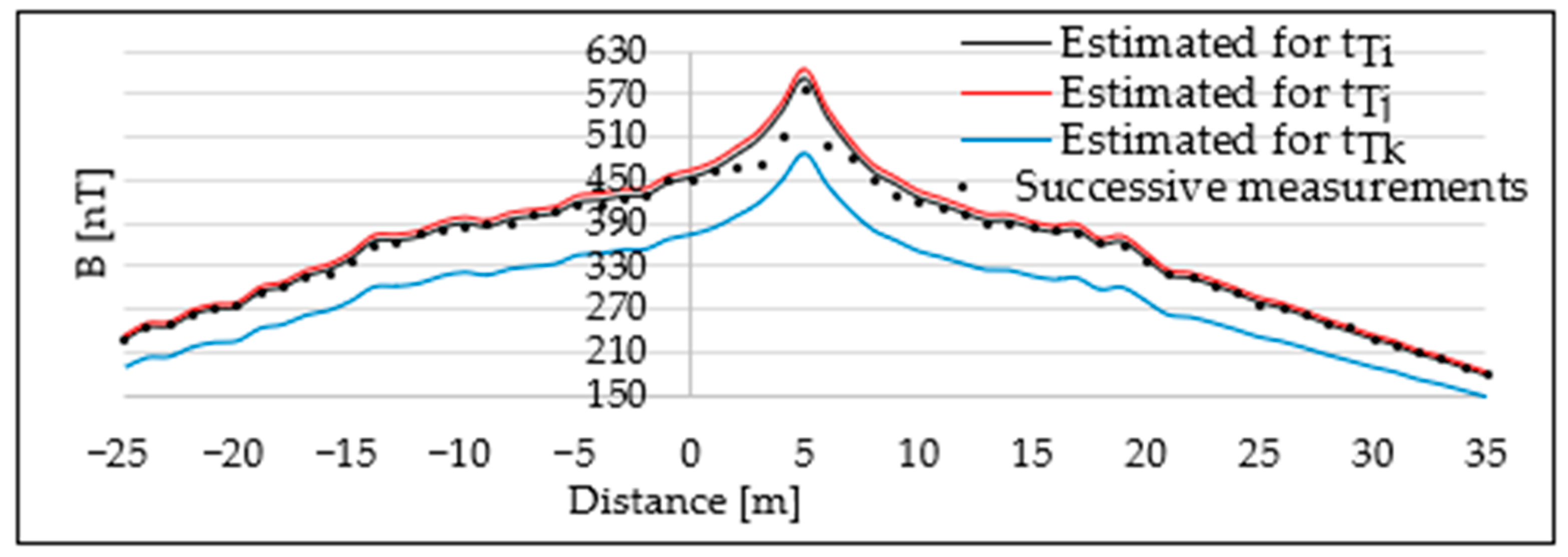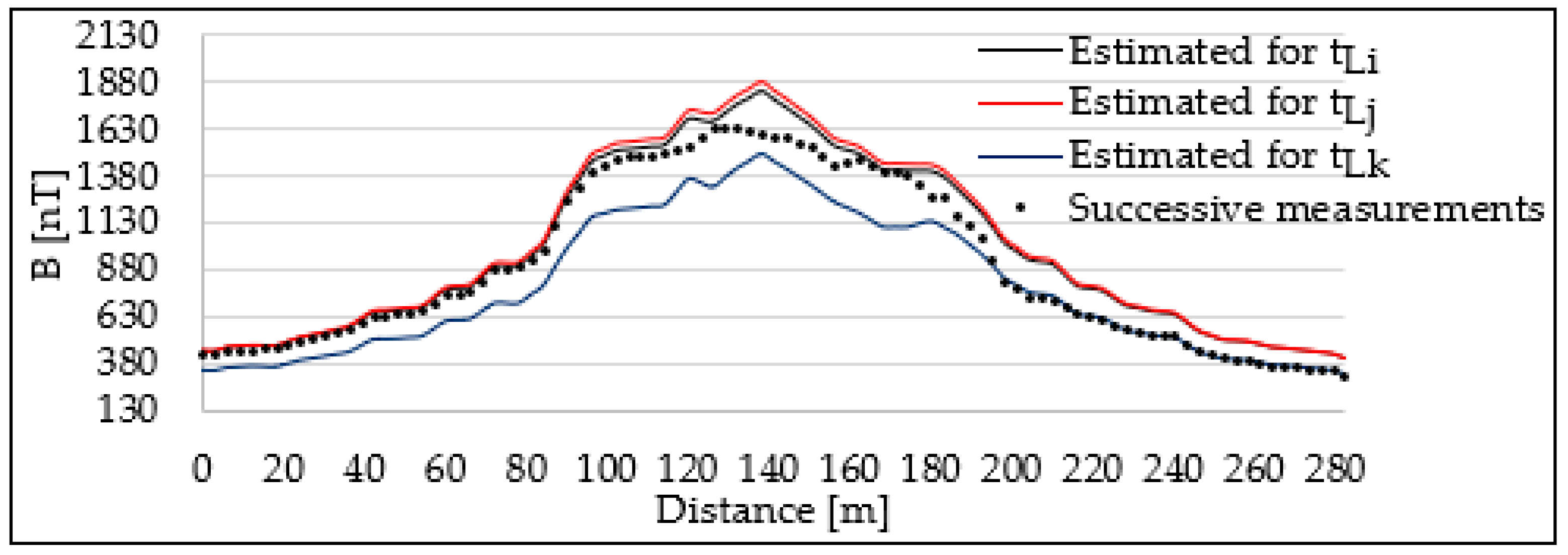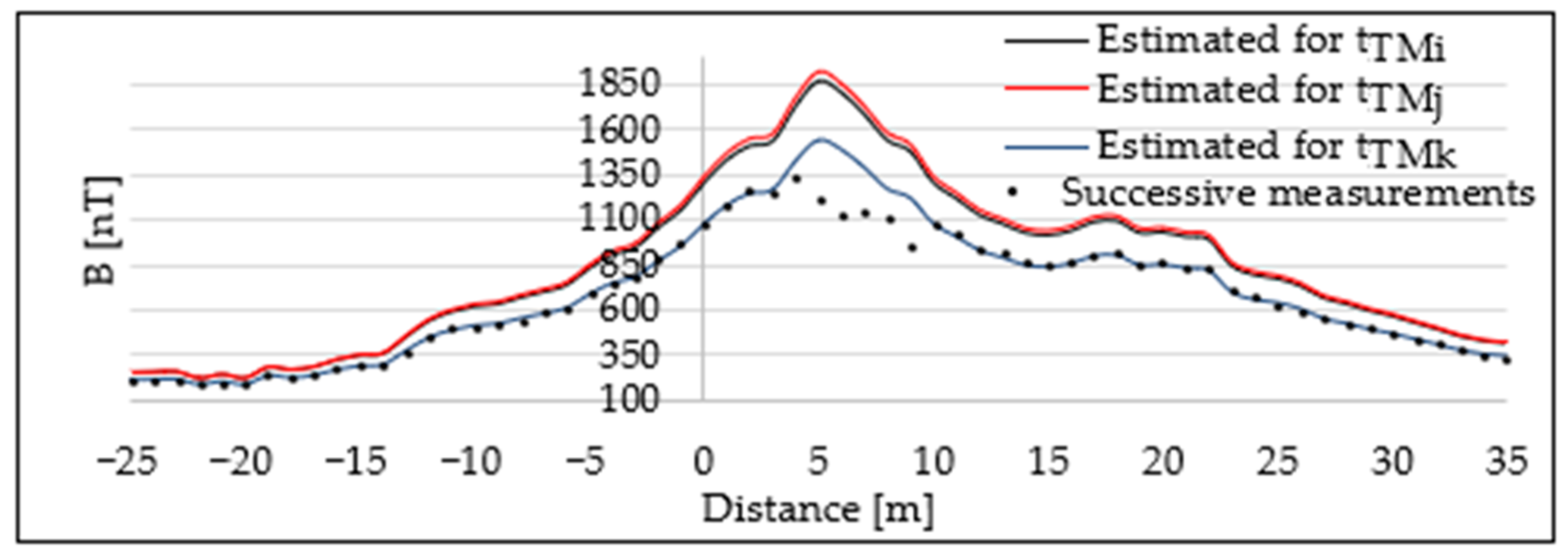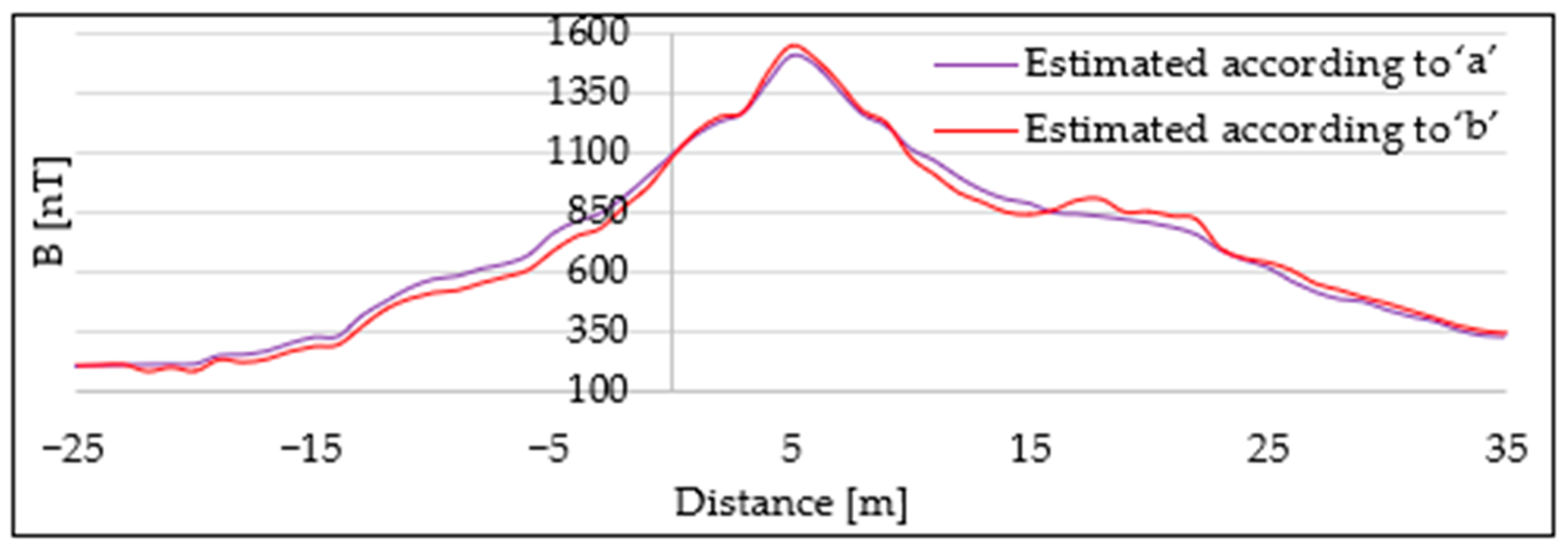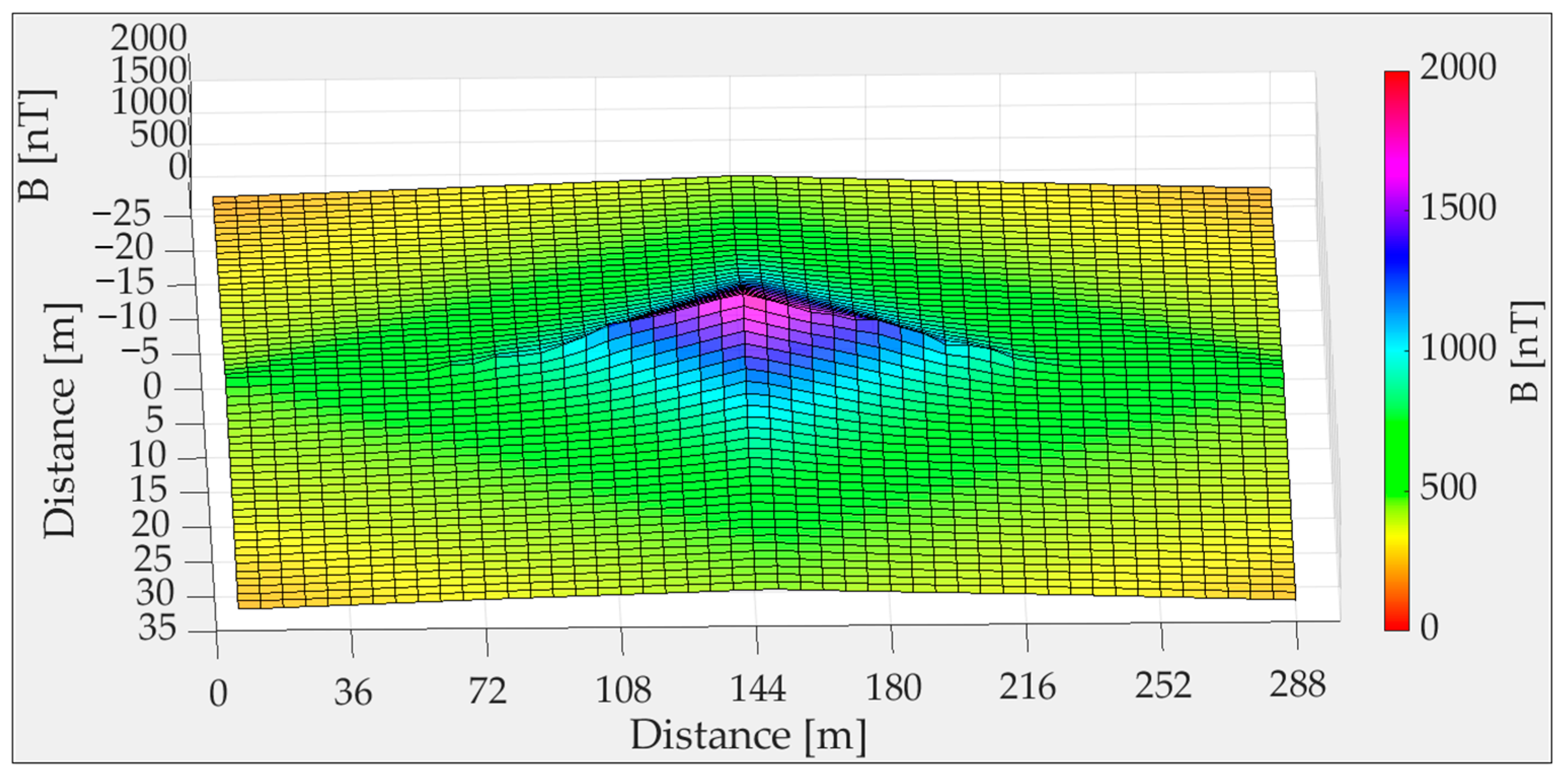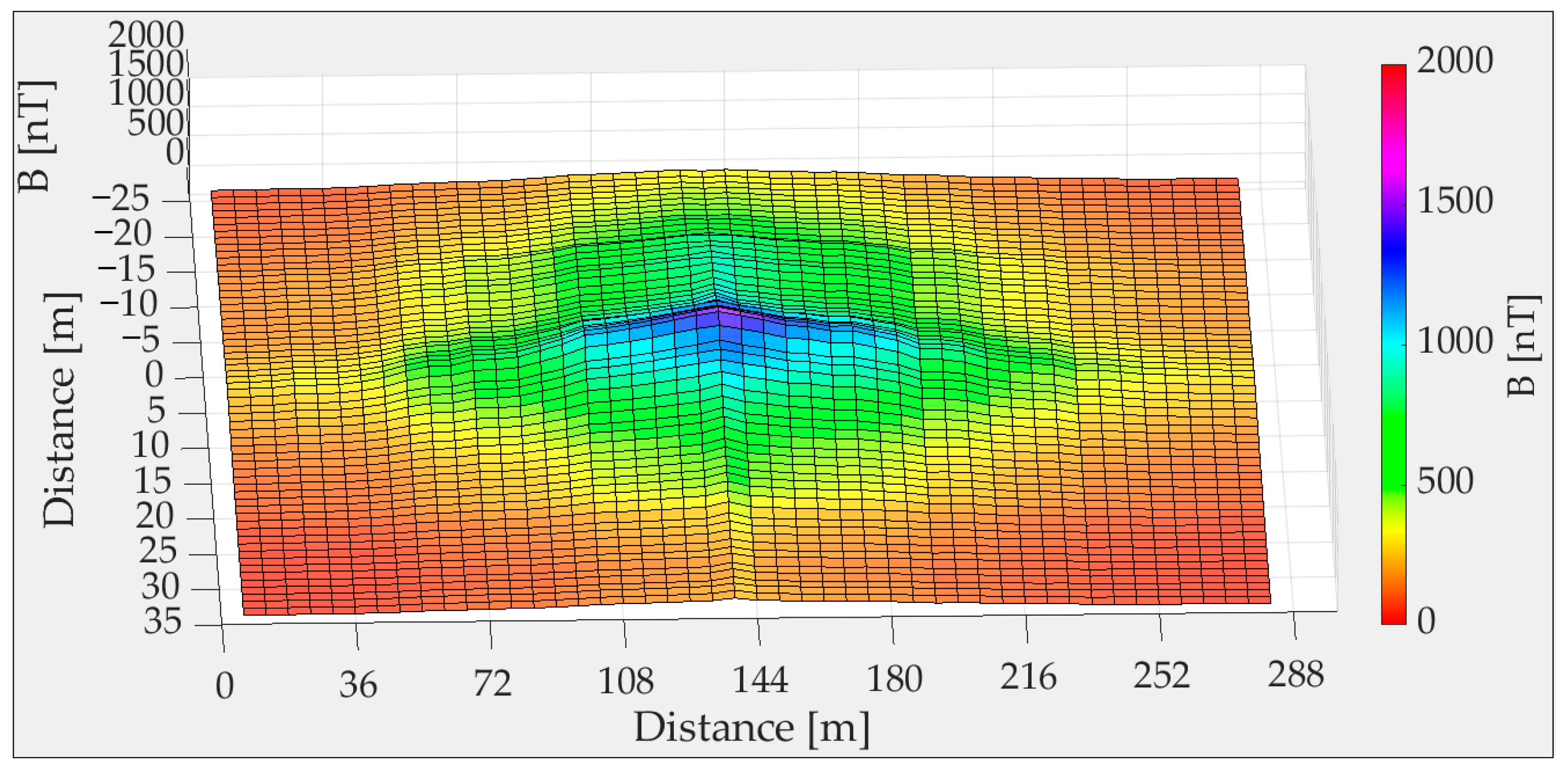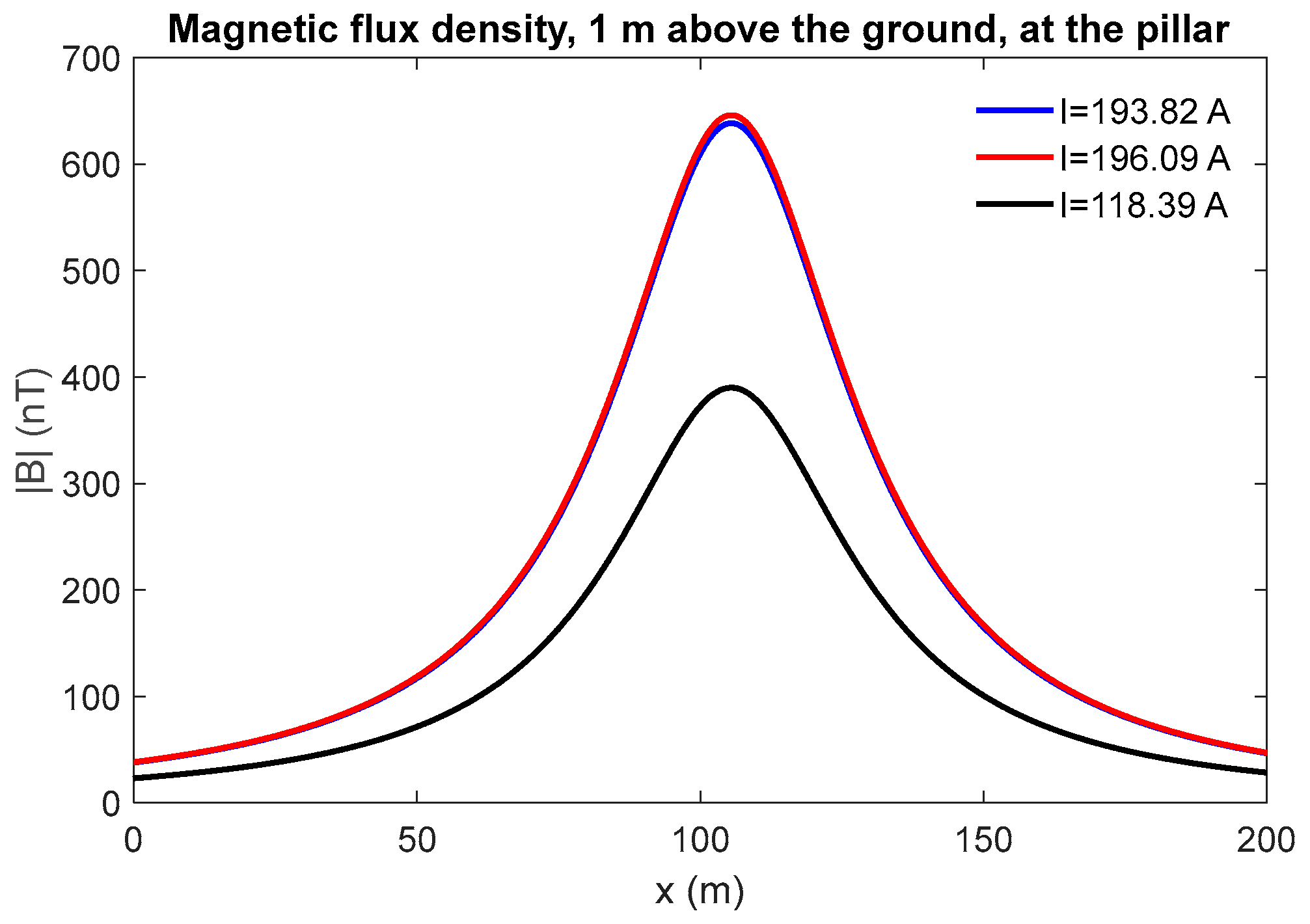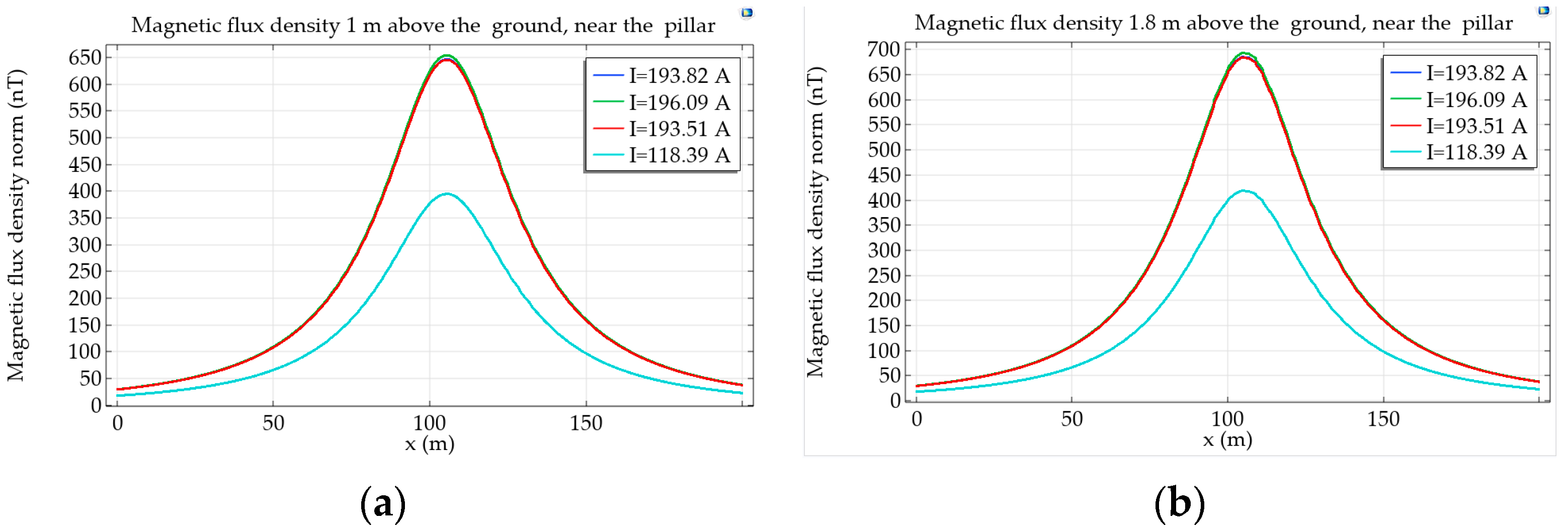1. Introduction
Electrical energy transport and distribution is done through overhead power lines (OPLs) as well as, where necessary, through underwater sea cables buried in the sea bed. The development of industrial and household applications both in urban and in rural areas lead to an expansion of the distribution networks so as to satisfy consumer demands. This means a network of high voltage power lines, as well as medium and low voltage lines is geared towards the end consumer. Overhead power lines, which host currents in the order of hundreds of amps, produce magnetic fields whose levels must be monitored due to the possible adverse effects on people and other living beings.
Overhead power lines work in the extra low frequency domain of the electromagnetic spectrum (ELF), i.e., 30–300 Hz. The current view, resulting from numerous researches and measurements, is to achieve a prudent avoidance of the exposure to electric and magnetic fields, both in occasional and in occupational situations.
Even if the maximum admissible values recommended by several international regulating authorities are rather large (of the order of 100 μT for the magnetic flux density), in cases of exposure for long periods of time, the threshold for B must be significantly smaller, especially for children, hence the necessity of a long-term survey and that of a complete characterization of the magnetic field exposure for the general population [
1,
2,
3,
4].
Numerous researches addressed the problem of determining, both analytically and experimentally, the electric and magnetic field produced by OPLs, trying to include various aspects such as ground proximity or the proximity of other conductors, the deformation of line conductors due to gravity, etc. In the following, a brief overview of some recent papers that address this subject is given.
In [
5], the formulae for computing the electric and magnetic field produced by a line current at high altitudes (110 km above the Earth’s surface) are developed. The model considers a flat Earth surface and a multilayer soil structure, with different electric properties, and uses a series expansion technique and the complex image method, as well as exact integral expressions for
and
components based on Maxwell’s equations and boundary conditions at the Earth’s surface.
In [
6], the authors use double complex numbers to incorporate in one expression the components of
,
Bx and
By (and the fact that these are complex numbers). Closed form expressions are derived for
, based on the Biot Savart Laplace (BSL) formula.
In [
7], the relations for the computation of the electric and magnetic fields produced by finite length OPLs, using the classical expression for the magnetic vector potential, are established.
Paper [
8] considers a 3D model of OPLs, with deformation of the lines due to gravity. The study combines the classical simulation current method (SCM) which replaces the actual unknown distribution of currents with simulated currents (in order to determine the magnetic fields) with two stochastic optimization methods, Particle Swarm (PS) and Differential Evolution (DE), used to optimize (determine) the position and number of simulated currents.
Another optimization method, Ant Lion Optimization (ALO), is used in [
9] to determine the position of the overhead power line conductors that minimize both the electric and magnetic fields at a height of 1 m above the ground. This method of field reduction implies, however, additional costs, due to the necessity to re-design OPLs.
In [
10], the authors propose a method for the analysis of multi-circuit overhead transmission lines using artificial neural networks (ANN) trained to estimate the real and imaginary parts of
Bx and
By at arbitrary points (x, y). The results are compared with BSL simulations and experimental measurements.
The magnetic field produced by submarine power cables is studied in papers such as [
11], where closed form solutions for thin wires with a helical shape are established, as well as in [
12], where both modelled and measured results for B are presented and the geomagnetic field is also taken into account.
The main objective of the present paper is to obtain a complete characterization of the magnetic field generated by overhead power lines in cases of long-term exposure, taking into account that B (rms) has large and unpredictable variations in time. The originality and novelty of the paper resides in the proposed hybrid method for estimating B using a correlation between spot measurements and long-term survey data. Both these measurements are made simultaneously using two measuring devices realized by the authors. Thus, maps with the spatial distribution of B in a large area near the OPL can be obtained for any moment of time, without the need of using a large network of sensors for measuring the magnetic flux density.
The results obtained using the proposed hybrid method and our instruments are in good agreement with the results obtained in simulations.
The organization of the paper is as follows:
Section 2 presents the materials and methods used in the study,
Section 3 presents the performed measurements,
Section 4 presents the results of simulations,
Section 5 discusses the obtained results and
Section 6 is reserved for the conclusions of the paper.
2. Materials and Methods
Magnetic flux density can be expressed in a three-orthogonal system as:
where B
1, B
2 and B
3 are the rms values of the components along the orthogonal directions. If the orthogonal system is Oxyz, then the three components are B
x, B
y and B
z. This simple observation ensures the fact that if the measurements are done with a sensor that determines the rms value of B, then the result is the same, irrespective of the sensor orientation.
The usual approach in monitoring the magnetic field produced by OPL is to trace a longitudinal and a transversal profile of B. If a mesh with a step size of 1 m is considered and measurements are conducted using only one instrument, the map for B is correct, if the current in the OPL is constant (rms) during the entire survey. Due to the fact that line currents are unpredictable, the magnetic field may vary significantly in the observation points, so a time variation for B (rms) must be also determined.
The method proposed in this paper takes into account both the spatial and the temporal variation of B (rms). The results are based on experimental determinations onsite and also on measurements and simulations (being thus a hybrid method). The experimental results are compared with the results obtained through numerical simulations that use the OPL configuration and the values of the line currents.
As a result of applying the proposed method, the spatial distribution (map) for B is obtained in a rectangular region with the dimensions (in this case study) of 60 m in transversal direction and 282 m in longitudinal direction, for any observation time during the automatic monitoring interval.
The geometric configuration of the OPL (2D transversal view) is outlined in
Figure 1a and in
Figure 1b. The real view of the line, with the measuring instruments, is presented.
2.1. Measurement Procedure
The measurements for B are carried out using two instruments for automatic survey of the magnetic field, which were designed by the authors and are presented in
Section 3.1 (Instrumentation). One of the instruments, MI
LTS, used for long-term survey, is placed in a fixed point under the geometric center of the OPL, at the mid-distance between two consecutive pillars. This instrument performs a survey for several hours, but this time can be increased to days or even months if proper housing and power supply is available. The long-term survey performed by MI
LTS records the rms values of B for almost 6 h (5 h and 31 min) with a time step of about 1 s.
The second measurement instrument, MI
SM (
Figure 1b), realizes spot measurements for B in the specified points of the longitudinal (LD) and transversal (TD) directions (with respect to the OPL), at points 1 m apart for TD and 3 m apart for LD. Unlike the procedure presented by the authors in [
13], which used a simple commercial instrument for spot measurements, the procedure used in this paper is based on two automatic monitoring systems.
In this way, besides a very good synchronization between the two instruments (MISM and MILTS), i.e., the spot measurements data and the long-term survey data necessary for the proposed hybrid method, supplementary information regarding B are obtained in all the observation points.
The time for completing the spot measurements with MISM is approximately 20 min for the transversal profile and 40 min for the longitudinal profile, in the case studied experimentally in this paper. Two transversal profiles were traced, one at the pillar (z = 0) and one at the mid-distance between consecutive pillars (z = d/2), where d is the distance between the two pillars. The second transversal profile was traced in order to verify and compare the results obtained with the proposed method, as will be later detailed.
The number of spot measurements in longitudinal direction can be reduced to one half due to the symmetry of the magnetic field with respect to the transversal middle plane z = d/2. A total of 61 spot measurements were taken in transversal direction at times tT1, tT2,..., tT61 and 95 measurements in longitudinal direction at times tL1, tL2,..., tL95.
2.2. Proposed Hybrid Method
Due to the fact that the current rms values have a permanent variation, in this paper, a method is proposed for the estimation of the magnetic field produced by the OPL both in transversal and in longitudinal directions for a specified time, e.g., tT1, for the entire transversal profile (EPT(tT1)) and similarly at tL1 for the entire longitudinal profile (EPL(tL1)).
The estimated magnetic flux density, Be, is determined using the measured values Bm and, also, taking into account the time variation of B (rms) recorded in one single fixed point (z = d/2) during the long-term survey, BLTS.
The transversal profile is traced sequentially, resulting in a set of data for B
m in 61 evenly spaced locations, namely B
m measured at point P
1 at time t
T1, and so on, B
m(P
1, t
T1), B
m(P
2, t
T2),..., B
m(P
61, t
T61). In the transversal profile estimated at time t
T1 (EP
T(t
T1)), the estimated value coincides with the measured value only at the first point P
1:
The next values will be estimated based on the values measured with MI
SM in subsequent points P
2, P
3, …, P
61, taking into account the time variation of B recorded with MI
LTS at the fixed point. Thus, at point P
2 the estimated value B
e is the following:
Relation (3) is based on system linearity and can be obviously rewritten in the form:
A similar procedure is employed for estimating the longitudinal profile, EPL(t), at a given time t, using the data measured with MISM for B along the line and the values recorded by MILTS in a fixed observation point P.
According to this procedure, the estimated values should be the same as those measured simultaneously in all the 61 discretization points for the transversal profile and in all the 95 points for the longitudinal profile (if such an experiment were realized), but this would require a very large number of instruments (MISM), thus being impractical.
Using the consecutive measurements for one transversal profile (PT) and one longitudinal profile (PL), measured with MISM, and the values for B obtained during the long-term survey in a fixed point (measured with MILTS), the transversal profiles for any , where is the step size in longitudinal direction, can be estimated for any moment of time. At the same time, the longitudinal profiles for any time during the observation procedure with MILTS can be also estimated.
Using this method, a matrix of 61 × 95 points (for the considered step size), containing the estimated values of B in a rectangular region under the OPL covering an area of 60 m × 282 m, is obtained for any moment of time during the survey with MILTS. Maps with the estimated values of B can be generated in MATLAB using these matrices.
2.3. OPL Modeling
The transversal view of the overhead power line is presented in
Figure 1. In order to determine the magnetic flux density, both an analytical and a numerical approach can be used. In this paper the focus is on the magnetic field (the electric field is not monitored), so that the ground proximity of the line conductors plays a less important role since the Earth’s magnetic permeability is close to μ
0. Moreover, as stated before, the OPL works at 50 Hz (extra low frequency domain) which further simplifies the analysis. At such a low frequency, the wavelength is of the order of thousands of km, and the propagation of the electromagnetic field, which occurs in direction Oz (along the line) is characterized by the Poynting vector
.
where
,
and
are the unit vectors of the three axes Ox, Oy and Oz. In sinusoidal steady state, the vectors are complex. Comparing the dimensions of the line, which may be of the order of tens of kilometers, to the wavelength, we can assert that the line is in quasi-stationary magnetic regime. This means that the time variation of the electric field is negligible, and the equations for the determination of the magnetic field are the same as in stationary regime:
Thus, in an environment of constant permeability μ
0, the magnetic flux density produced by a thin conductor can be determined using the Biot–Savart–Laplace formula (BSL):
which, for the long line conductor, becomes (
Figure 2b) the following:
In (8), Ik is the complex rms value of the current in conductor k. In the case of the OPL line, there are six conductors which may or may not be current-carrying conductors (some currents may be zero).
The total magnetic field is obtained by superposition:
3. Measurements
3.1. Instrumentation
The proposed hybrid method is based on the data obtained during the automatic long-term survey performed using the two instruments MI
SM and MI
LTS. These new/original instruments were designed, realized and calibrated by the authors [
14,
15,
16] for the purpose of measuring magnetic fields, being suitable in monitoring magnetic field exposure for the general population.
Although there are small differences between MISM and MILTS, each of the two instruments consists of an isotropic field sensor (three linear coils), an electronic signal processing circuit (amplifier and integrator), a data acquisition module and a laptop that hosts several virtual instruments realized in LabVIEW.
Both measurement systems record and process the waveforms for the three components of B. The processing and LabVIEW module can perform a frequency analysis and compute the rms and peak-to-peak values, as well as a statistical post-processing of the recorded data. These two instruments can perform a long-term survey of the magnetic field, recording samples of B every second for a frequency range of the B components up to 100 kHz, which is appropriate for observing the biological effects of the magnetic field.
The calibration of these instruments was conducted using a reference magnetic field (standard-field method), with an uncertainty of less than 5%. This uncertainty of the measurement instrument was also verified by comparison with commercial instruments.
The experimental recording performed with MILTS lasted for 5 h and 31 min, between 9:37 am and 3:08 p.m. At the same time interval, the transversal profiles near the pillar (in z = 0) and at the mid-distance between two pillars (z = d/2), and also the longitudinal profile B (0, y, z), z ∈ [0, d], were traced with MISM at a height y = 1 m above the ground.
The OPL considered in experiments (
Figure 1b) is a double three-phase line 2 × 220 kV with RST-RST phase disposition, situated in Iasi County, Romania. The geometrical configuration of the line as well as the current rms values are known and are used in the numerical simulations.
3.2. Measurement Results
During the experiments, two profiles for B were obtained: one in transversal direction for z = 0, PT, and a longitudinal profile PL for . A supplementary verification and validation of these results is performed using measurements taken for a transversal profile at the mid-distance between two consecutive pillars, PTM.
Figure 3 depicts the transversal profile near the pillar using 61 consecutive measurements in points 1 m apart, at different moments of time (since only one instrument MI
SM was used). The maximum value for |B| is obtained at approximately 5 m from the central symmetry plane of the OPL, due to the fact that the currents in the second line (conductors (1′), (2′) and (3′) in
Figure 1) were zero (line out of service).
The longitudinal profile between two pillars, P
L, was traced using spot measurements in points 3 m apart for the distance d = 282 m,
Figure 4. In the considered case, the experimental procedure for P
L lasted 40 min.
The plots in
Figure 3 and
Figure 4 show rather large variations of |B|, even for neighboring points. This is due to the variation of |
Ik| in time, allowing for the instrument MI
SM to be moved to the next position.
However, most of these variations can be smoothed (leveled) using the proposed method for estimating the magnetic field profile at a given time, this being equivalent to the case when all the measurements are carried out simultaneously. Some irregularities in |B| still persist even after applying this method due to errors produced by the fact that the Earth’s surface is not flat (small differences in the distance between the line and the instrument occur).
Although the profiles P
T and P
L give sufficient data in order to plot a map of |B| in a rectangular region beneath the line, a second transversal profile P
TM was recorded at a distance z = d/2. This profile, represented in
Figure 5, is used to verify the proposed method for field estimation. The procedure is based on the comparison of the data in P
TM with the transversal profile estimated using the data in P
T, taken in z = 0, the data in P
L and the time variation of B obtained with MI
LTS during the long-term survey.
Thus far, only the data from spot measurements with MI
SM were presented. In the following, the data from the long-term survey performed with MI
LTS will be presented and discussed.
Figure 6 presents the recordings made for B rms with MI
LTS for the entire observation interval of 5 h and 31 min. In this recording, a significant temporal variation of the magnetic field can be observed, justified by the time variation of the rms current in the line. These variations can be correlated with the variations of B identified in the measured data for the longitudinal profile (plotted in
Figure 4).
Using the long-term survey instrument, MI
LTS, a time and frequency analysis of the recorded signal can be performed.
Figure 7 presents both the time variation and the spectral analysis for the field components B
x, B
y and B
z.
A statistical post-processing of the recorded results over the observation time interval can be also performed.
Table 1 presents the results of post-processing, i.e., date and time of observation, number of measurements, minimum, maximum and average values of B, standard deviation, number of recorded data larger than the average value and percentage of exceeding values.
The currents in the line, further used in simulations, are known only for six moments in time (10 a.m., 11 a.m.,..., 3 p.m.), but the number of values recorded for B during the long time survey is 17,530, with a time step of about 1 s (17,530 measurements in 19,860 s). Moreover, if the range for the current rms values is from 118 to 196 A, the range of values for B recorded by MILTS is from 724 to 1375 nT.
5. Discussions
In order to obtain a complete map of the magnetic flux density produced by an overhead power line (OPL), a large number of simultaneous measurements taken over a significant time interval would be necessary. This approach that takes into account the spatial and temporal variation of B (rms) is not feasible due to the large number of instruments necessary in the survey and the complexity of the entire operation.
That is why characterization of the magnetic fields produced by the OPL is usually performed using a transversal and a longitudinal profile obtained in successive measurements in a number of observation points. This approach is easier to implement and needs only one measurement instrument, but it is not complete because it does not distinguish between the spatial and temporal variations of B and becomes incorrect when the magnetic field has large variations in time, which happens in most cases.
The transversal profile P
T obtained through successive measurements and presented in
Figure 3 is able to characterize the magnetic field in the direction perpendicular to the line, since B has small variations at the time these data were collected. The small deviations from the real values can be caused by terrain oscillations of levels and small errors in positioning the instrument.
In contrast, the longitudinal profile P
L, obtained experimentally through successive measurements and presented in
Figure 4, cannot characterize correctly the spatial variation of B along the line in direction Oz, due to the large variations of B during the experiment.
That is why, in this paper, a new method for estimating the longitudinal profile and the transversal profiles for B at different positions along the line (z ∈ [0,d]) is proposed, thus allowing for spatial maps of B to be represented at different moments of time. In the case considered in this study, the map for B covers an area of 60 m × 282 m. In order to obtain the estimated profiles for B, two instruments are used, one for spot measurements in different points (MI
SM) and one for a long-term survey (MI
LTS), which record automatically and continuously the values of B in a fixed point. Thus, using only two instruments, 156 values for B are collected using MI
SM (61 for P
T and 95 for P
L) and, using MI
LTS, the values of B can be estimated in 5795 points at any moment of time (17,530 instances of time, according to
Table 1). Some of the estimated results are presented in
Figure 8,
Figure 9,
Figure 10 and
Figure 11. Two maps for the magnetic flux density are also presented in
Figure 12 and
Figure 13, at moments corresponding to the maximum and minimum recorded values of B, respectively.
The first validation of the proposed method is conducted within the method by obtaining two estimated transversal profiles at the mid-distance between two consecutive pillars P
TM (
Figure 5). The plots in
Figure 11 show that the two estimations for the same profile at the same moment of time, obtained using two separate sets of data, are almost identical, with relative differences between the two profiles of under 9%.
In order to verify or validate the proposed method, calculations for B using analytical and numerical methods were also used. The maximum relative difference between the hybrid method and data from analytical simulations, using estimations of the transversal profile at the pillar, was 5.4%.
The two instruments MISM and MILTS were designed, realized and calibrated by the authors, with an uncertainty in the measured value of B of under 5%. Supplementary measurement uncertainty may also occur due to errors in positioning the instrument both in horizontal and in vertical directions and also due to possible errors in the time synchronization of the two instruments.
The proposed hybrid method of estimation may be used to map other sources of electromagnetic field, and, by using an automatic recording of the magnetic flux density and of the electric field, maps for both B and E can be obtained [
14,
15].
6. Conclusions
This paper presents a new hybrid method to estimate and map the magnetic flux density produced by overhead power lines in a large region beneath the OPL and for a long period of time using a minimized number of spot measurements and a long-term survey of B. The method is based on the correlation of data from a transversal profile and those from a longitudinal profile of B, obtained by successive measurements made in a short time interval, with the data from the long-term survey, both sets of data being obtained with instruments developed by the authors.
In order to validate the results of the estimations, simulations are carried out based on the analytical and numerical methods for magnetic field determination. The relative difference between the estimation and simulation results is under 5.5%.
All the measured, estimated and calculated values in the analyzed case are below the threshold imposed by international regulations for human exposure to magnetic fields. It is to be mentioned, however, that there are reports suggesting that long time exposure of children to magnetic fields in the ELF domain must be limited to much lower values than those recommended by international regulating organizations, this being a subject of ongoing research.
Thus, the need for estimating and mapping the magnetic field produced by OPL (an important source of magnetic fields) and characterizing the human field exposure to complex fields is a topic of major interest that relates to public health concerns.
